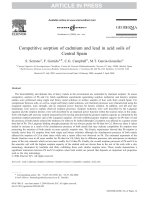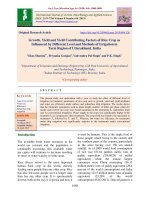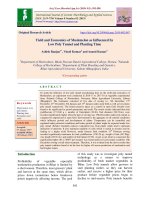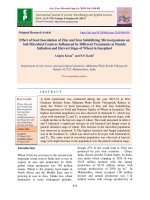Soil physical properties and productivity as influenced by soil moisture conservation measures under maize based cropping system in acid soils of North East India
Bạn đang xem bản rút gọn của tài liệu. Xem và tải ngay bản đầy đủ của tài liệu tại đây (263.64 KB, 9 trang )
Int.J.Curr.Microbiol.App.Sci (2017) 6(3): 428-436
International Journal of Current Microbiology and Applied Sciences
ISSN: 2319-7706 Volume 6 Number 3 (2017) pp. 428-436
Journal homepage:
Original Research Article
/>
Soil Physical Properties and Productivity as Influenced by Soil Moisture
Conservation Measures under Maize Based Cropping System
in Acid Soils of North East India
Bidyapati Ngangom1*, Anup Das2, Savita2 and R. Krishnappa2
1
Department of Agronomy, Uttar Banga Krishi Viswavidyalaya, Pundibari, Cooch Behar736165, West Bengal, India
2
Division of Crop Production, ICAR Research Complex for NEH Region, Umiam, Meghalaya,
India
*Corresponding author
ABSTRACT
Keywords
Soil moisture
conservation, Crop
residue mulch,
Water holding
capacity, Maize
equivalent yield,
North Eastern Hill
region.
Article Info
Accepted:
10 February 2017
Available Online:
10 March 2017
Prevalence of moisture stress and poor crop establishment are major constraints for the
cultivation of rabi crops in maize fallows which results in reduced cropping intensity and
insufficient food production in North Eastern Hill region. Hence, the present field
experiment was conducted with different maize based cropping systems under diverse soil
moisture conservation (SMC) options at mid-altitudes of Meghalaya. Results revealed that
cultivation of black gram after preceding maize crop with retention of maize
stalk+Tephrosia purpurea mulching increased the soil moisture content followed by maize
– pole type French bean with maize stalk+Tephrosia purpurea. Application of Maize
stalk+Ambrosia artemisiifolia and maize stalk+Tephrosia purpurea decreased soil BD and
increased water holding capacity (WHC) substantially. Besides, Maize–black gram (CS5)
recorded lowest soil bulk density (BD) of 1.24 Mg m-3 whereas highest BD was being
recorded in no mulch at all depths. There was significant (76 %) increase in WHC under
maize-black gram cultivation than maize- fallow at 0-15 cm, maximum WHC being
recorded in maize stalk+Tephrosia purpurea at all the depths (74.5, 71.9, and 70.3%). The
highest maize equivalent yield was obtained from maize – pole type french bean under
maize stalk+Tephrosia purpurea (9.5 t ha-1) followed by Maize stalk+Ambrosia
artemisiifolia (8.8 t ha-1) soil moisture conservation measure.
Introduction
the interactive effects of residue application
rates on overall soil physical quality under a
range of tillage systems (Singh et al., 2013).
The use of less tillage with increase residue
preservation enhance water conservation and
other benefits like decreasing soil erosion and
increase organic matter content resulting in
improved soil physical properties (Blanco and
Lal, 2008).
Mulching improves the soil physical
condition by enhancing aggregation and
conserving soil moisture by increasing
infilteration, checking losses by evaporation
and run off (Nalayini et al., 2009). The
positive effect of conservation tillage and
crop residues on soil physical quality and soil
organic carbon pool are well established, only
a limited number of studies have evaluated
428
Int.J.Curr.Microbiol.App.Sci (2017) 6(3): 428-436
It is hypothesized that after the harvest of
kharif crop, cultivation of short duration crops
with residual moisture would enhance
cropping intensity and water productivity in
the region. In this background the present
study was planned to investigate the effect of
soil moisture conservation (SMC) practices
on soil properties and productivity of rabi
crops after harvest of maize.
requirement. The recommended dose of
fertilizers and seeds were placed in the
furrows and covered with soil and the mulch
materials (Table 1). The rabi crops of French
bean (BT and PT) and blackgram were sown
on 24th August. After the germination of
seeds, the maize stalks were cut and spread all
over the field just above the mulches to cover
the soil surface. This way, there were two
layers of mulch i.e. maize stalk mulch and
Ambrosia artemisiifolia/Tephrosia purpurea
mulch to cover the soil surface.
Materials and Methods
A field experiment was conducted at the
upland experimental block of Agronomy,
ICAR Complex for NEH Region, Umiam,
Meghalaya during the year 2012. The
experimental site is located at 25041ʺ N
latitude and 91054ʺ E longitude with an
elevation of 980 m above mean sea level. The
total rainfall received during crop period was
2052.5 mm, the highest rainfall being
received in the month of August (440 mm)
and no rain received in December. The
experiment was laid in three time replicated
split plot design by selecting five maize based
cropping sequences Viz., CS1: Maize – fallow,
CS2: Maize- –rapeseed, CS3: Maize– French
bean (bush type-BT), CS4: Maize–French
bean (pole type- PT) and CS5: Maize–black
gram as a main plots and four soil moisture
conservation (SMC) measures; M0-No mulch
(residue removal), M1- In-situ maize stalk
mulch, M2- M1+Ambrosia artemisiifolia (Rag
Weed) @10 t ha-1 and M3- M1+Tephrosia
purpurea (White hoary pea) @ 10 t ha-1 were
included as subplots. The maize was sown on
30th April with all the recommended
agronomic practices (Table 1).
Soil sampling and analysis
Soil moisture
The soil moisture content was recorded at
different soil depths i.e., 0-15 cm, 15-30 cm
and 30-45 cm at 15 days interval. Soil
samples were collected from central spots of
the plots in between the crop rows. The
samples were dried in hot air oven at 105 0C
for till the samples attained constant weight.
To calculate moisture content of soil by
gravimetric method the following formula
was used (Jalota et al., 1998)
Soil moisture (%) =
Weight of fresh soil-weight of oven
dried soil
× 100
Weight of oven dried soil
Soil moisture stock
Soil moisture stock (SMS) was calculated at
the flowering stages in all the crops. It was
calculated with the following formula and
expressed in cm per 45 cm
The fresh biomass of Ambrosia artemisiifolia
and Tephrosia purpurea were collected from
nearby farm areas (road sides, wastelands,
farm fences etc.). The fresh biomass was
weighed and applied as mulch in between the
rows of standing maize 20 days before the
harvest of maize as per the treatment
SMS =
Depth (cm)
429
× Bulk density (Mg m-3) ×
Int.J.Curr.Microbiol.App.Sci (2017) 6(3): 428-436
runoff. Besides, it acts as an insulator for
solar radiation and do not permit direct
contact with soil, which avoid continuity of
capillaries for the evaporation loss of water
through soil profile (Rathore et al., 1998).
Higher soil moisture content under mulched
plots than the no-mulched plots at all the soil
depth was also reported by Pervaiz et al
(2009).
Bulk density
Bulk density (BD) was determined by the
core method (Blake and Hartge, 1986) using
cores of 5.8 cm height and 5.4 cm diameter at
0-15 cm, 15-30 cm and 30-45 cm depth and
oven dried at 1050C (one sample per plot).
Water holding capacity
Water holding capacity (WHC) was measured
at three depths 0-15, 15-30 and 30-45 cm after
the harvest of rabi crop. WHC was
determined by using perforated can as
described by Jalota et al., 1998.
Soil moisture stock
The cropping systems exhibited significant
effect on soil moisture stock recorded during
crop growth (Table 2). Maximum soil
moisture stock was recorded under maizeFrench bean (BT) system (21.4 cm/45 cm)
which was significantly higher compare to
maize-rapeseed system (17.3 cm/45 cm).
There was 24% higher soil moisture stock
under maize-French bean (BT) system than
maize- rapeseed system. The soil moisture
stock of different cropping system in
descending order were maize- French bean
(BT) (21.4 cm/45 cm) > maize-black gram
(19.8 cm/45cm) > maize-French bean (PT)
(19.8 cm/cm) > maize-fallow (19.7 cm/45cm)
> maize- rapeseed (17.3 cm/45 cm) cropping
system.
Results and Discussion
Variation in soil moisture content
Higher soil moisture content was recorded
under maize-French bean (PT) system during
earlier growth period. In particular, from 60
DAS to harvest, maize-blackgram recorded
higher soil moisture content followed by
maize-french bean (PT) as compared to other
cropping systems (Fig. 1).
The higher soil moisture in maize-blackgram
system might be due to its spreading canopy
nature and broad leaves of blackgram which
cover ground effectively and reduced
exposure of soil surface to the sun directly
and resulted in reduction of relentless
evaporation from soil surface. Similar
findings were reported by Obalum et al
(2010) in soybean with special reference to
growth habit. Among the SMC measures,
maximum soil moisture content was recorded
under M1+Tephrosia purpurea and M1+
Ambrosia artemisiifolia mulch practices at all
the crop growth stages and the lowest soil
moisture content was found in no mulch (Fig.
2). The even distribution of crop residues on
the soil surface which blocks the direct
evaporation from soil reduces the surface
The SMC measures had significant influence
on soil moisture stock at flowering stage. The
highest soil moisture stock was found with the
retention of M1+ Tephrosia purpurea mulch
(20.5 cm/45 cm) which was 11 % higher than
no mulch. The soil moisture stock under M1+
Tephrosia purpurea mulch, M1+ Ambrosia
artemisiifolia mulch and in-situ maize stalk
mulch were at par among them but remained
significantly superior to no mulch. Sharma et
al (2010) observed significant contribution of
mulching in succeeding crop after maize
towards enhanced nutrient supply particularly
N, besides higher soil moisture content in the
early growth stages.
430
Int.J.Curr.Microbiol.App.Sci (2017) 6(3): 428-436
Table.1 Input and cultural practices followed for the experiment
Particulars
Maize
(Zea mays L.)
Rapeseed
French bean
French bean (pole)
Black gram
(Brassica
(bush) [Phaseolus
[Phaseolus vulgaris
(Vigna mungo
compestris L.)
vulgaris L.]
L.]
Viridis)
Variety
DA-61A
TS-46
Arka anoop
Naga local
PD-4
Date of sowing
30th April
21st September
24th August
24th August
24th August
Spacing (cm)
60 x 20
30 x 5
30 x 15
30 x 15
30 x 10
FYM
5 t ha-1
-
-
-
-
60:60:40
60:60:40
50:60:40
50:60:40
20:60:40
10
10
8
8
12
25
25
20
20
20
45
50
40
40
40
30
30
-
-
-
Round up 3G
-
-
-
-
9thAugust
16th December
2th November
16th November
1st December
Fertilizer doses (N:P2O5:K2O
kg/ha)
Gap filling (DAS)
Hand weeding (DAS)
Top dressing of N (DAS)
Pesticide application (DAS)
Date of harvesting
431
Int.J.Curr.Microbiol.App.Sci (2017) 6(3): 428-436
Table.2 Effect of cropping systems and soil moisture conservation measures on SMS at
flowering stage, soil bulk density and WHC of rabi crops
SMS
(cm 45
Cropping Systems
cm-1)
Maize – Fallow
19.7
Maize – Rapeseed
17.3
Maize – French bean (BT)
21.4
Maize – French bean (PT)
19.8
Maize – Black gram
19.8
CD (p=0.05)
1.00
Soil moisture conservation measures
No mulch (Mo)
18.49
In-situ Maize stalk mulch (M1)
19.39
M1+Ambrosia artemisiifolia (M2)
20.01
M1+ Tephrosia purpurea (M3)
20.53
CD (p=0.05)
0.89
Bulk density (Mg m-3)
WHC (%)
Treatments
A
B
C
A
B
C
68.9
71.9
71.2
72.1
74.2
3.42
66.8
70.1
69.0
68.6
70.50
3.83
65.8
68.0
67.3
67.4
66.13
NS
1.28
1.25
1.28
1.27
1.24
0.03
1.32
1.36
1.25
1.29
1.29
NS
1.36
1.39
1.37
1.36
1.35
NS
68.3
71.5
72.4
74.5
4.33
66.1
68.1
69.9
71.9
4.03
63.4
66.3
67.7
70.3
5.49
1.27
1.26
1.27
1.25
NS
1.35
1.37
1.34
1.34
NS
1.40
1.37
1.35
1.35
NS
BT-Bush type, PT-Pole type, SMC -Soil moisture stock, WHC - Water holding capacity, CD (P=0.05)- Critical
difference, NS- Non –significant, A- 0-15 cm, B-15-30 cm, C- 30-45 cm
Table.3 Interaction effect on maize equivalent yield (t ha-1) as influence by cropping systems
and SMC measures
4.31
Maize –
French
bean
(BT)
6.42
Maize –
French
bean
(PT)
7.22
3.11
4.53
6.59
M2
3.13
4.56
M3
3.17
Mean
3.12
Maize –
Black
gram
Mean
5.58
4.7
8.01
6.25
5.1
7.14
8.83
6.93
5.5
4.75
7.94
9.50
7.46
5.9
4.54
7.02
8.39
6.55
Maize Fallow
Maize Rapeseed
Mo
3.06
M1
Treatments
SE (m)±
CD (p=0.05)
Cropping systems
0.10
0.33
SMC measures
0.07
0.20
For SMC at same or different level of CS
0.15
0.48
For CS at different level of SMC
0.14
0.40
BT-bush type, PT-pole type, CS- Cropping system, SMC- Soil moisture conservation, SE (m) ± -Standard error of
mean, CD (p=0.05) - Critical difference
432
Int.J.Curr.Microbiol.App.Sci (2017) 6(3): 428-436
Fig.1 Soil moisture content at 0-15 cm, 15-30 cm and 30-45 cm soil depth as influenced by
cropping systems from sowing to harvest. Note: BT-Bole type, PT-Pole type, SMC- Soil
moisture conservation, DAS-Day after sowing, MSM- Maize stalk mulch
433
Int.J.Curr.Microbiol.App.Sci (2017) 6(3): 428-436
Fig.2 Soil moisture content as influenced by soil moisture conservation measures at 0-15 cm, 1530 cm and 30-45 cm depth from sowing to harvest. Note: BT-Bole type, PT-Pole type, SMCSoil moisture conservation, DAS-Day after sowing, MSM- Maize stalk mulch
434
Int.J.Curr.Microbiol.App.Sci (2017) 6(3): 428-436
(9.5 t ha-1) followed by M1+ Ambrosia
artemisiifolia mulch (8.83 t ha-1). Choudhary
and Kumar, (2013) also reported higher MEY
in maize- French bean system due to higher
market price of French bean.
Water holding capacity and bulk density
Significant influence of cropping systems and
SMC measure were recorded on WHC.
Maximum WHC was observed under maizeblack gram system followed by maize-French
bean (PT) system. Higher BD under no- till
than conventional tillage would have
increased soil WHC; in association with
reduced water evaporation from the soil
surface due to residue cover would have
enhanced available water for the crop (DeVita et al., 2007). Lui et al., (2013) reported
that straw mulching is an effective practice
for increasing the soil WHC. Significant
effect of cropping systems on BD at 0-15 cm
and non-significant effect at 15-30 cm and 3045 cm depth were observed. Maize-black
gram system recorded the lowest soil BD
(1.24 Mg m-3) followed by maize-rapeseed
system (1.25 Mg m-3). In general, BD
increased with increase in soil depth (Table
2). In the similar way, Ghuman et al., (2001)
concluded that mulching decreases BD of the
surface soil.
The present investigation implied that the
double layer mulching with in-situ maize
stalk and fresh weed biomass of Ambrosia
artemisiifolia or Tephrosia purpurea is a
viable and recommendable practice for soil
moisture conservation and enhanced yield of
rabi crops over non mulching under maize
based cropping system in mid-altitudes of
Meghalaya. Hence, the present study clearly
and consistently substantiates the role of
mulching in different rabi crops by achieving
higher yield, conserving increased soil
moisture with improved soil physical
properties under maize based cropping system
of NEH region.
References
Blake, G.R. and Hartge, K.H. 1986. Bulk
density. In: Klute, A. (Ed.), Methods
of Soil Analysis, Part I, ASA
Monograph No. 9. Lewis Publishers,
Madison, WI, pp. 363– 376.
Blanco, H and Lal, R. 2008. Principles of soil
conservation
and
management.
Springer Publ. Co., New York.
Choudhary, V.K. and Suresh, K.P. 2013. Crop
and water productivity, profitability
and energy consumption pattern of a
maize-based crop sequence in the
North Eastern Himalayan Region,
India. Archives Agronomy Soil Sci.,
59(5): 653–669.
De-Vita, P., Di Paolo, E., Fecondo, G., Di
Fonz, O. N. and Pisante. M. 2007. Notillage and conventional tillage effects
on durum wheat yield, grain quality
and soil moisture content in southern
Italy. Soil and Tillage Res., 92(1-2):
69–78.
In case of SMC measures, non-significant
effect on BD was observed at all the depths.
At deeper layer from 15-45 cm the BD ranged
from 1.25 to 1.40 Mg m-3under no mulch. The
highest BD was recorded in soil under residue
removal at all depths and lower BD was
observed at 0-15 cm where M1+ Tephrosia
purpurea mulching practiced (1.25 Mg m-3).
Similar BD was found under M1+ Tephrosia
purpurea and M1+ Ambrosia artemisiifolia
mulch at 0-15 and 15-30 cm, respectively.
Effect on maize equivalent yield (MEY)
Interaction effect of cropping systems and
SMC measures on MEY was significant
(Table 3). The maximum MEY was obtained
under maize-french bean (PT) cropping
system with the retention of maize stalk
mulch along with Tephrosia purpurea mulch
435
Int.J.Curr.Microbiol.App.Sci (2017) 6(3): 428-436
Jalota, S.K., Khera, R. and Ghuman, B.S.
1998. Method in soil physics. Narosa
publishing House, New Delhi. pp: 6567.
Liu Yang., Maosheng, Gao., Wei, Wua.,
Sikander Khan. Tanveer., Xiaoxia,
Wena, Yuncheng Liao. 2013. The
effects
of conservation tillage
practices on the soil water-holding
capacity of a non-irrigated apple
orchard in the Loess Plateau, China.
Soil and Tillage Res., 130: 7–12.
Nalayini,
P.,
Anandham,
R.,
Sankaranarayanan, K. and Rajendran,
T. P. 2009. Polyethylene mulching for
enhancing crop productivity and water
use efficiency in cotton (Gossypium
hirsutum) and maize (Zea mays)
cropping system. Indian J. Agronomy,
54(4): 409-414.
Obalum, S.E, Igwe, C.A., and Obi, M.E.
2010. Moisture dynamics in selected
layers of a course-textured mineral
soil as induced by tillage-mulch
practices under sorghum and soybean
at Nsukka, Southern Nigeria. Res. J.
Soil and Water Management, 1(2): 45-
60.
Pervaiz, M.A., Iqbal, M., Shahzad, K. and
Anwar-UI-Hussan. 2009. Effect of
mulch on soil physical properties and
N P K concentration in maize (Zea
mays) shoots under two tillage system.
Int. J. Agri. and Biol., 11(2): 119-124.
Rathore, A.L., Pal, A.R. and Sahu, K.K. 1998.
Tillage and mulching effects on water
use, root growth and yield of rainfed
mustard and chickpea grown after
lowland rice. J. Sci. Food and Agri.,
78: 149–161.
Sharma, A.R., Singh, R., Dhyani, S.K. and
Dube, R.K. 2010. Effect of live
mulching with annual legumes on
performance of maize (Zea mays) and
residual effect on following wheat
(Triticum aestivum). Indian J.
Agronomy, 55(3): 177-84.
Singh, M.K., Lal, R., Merrie, and AnnVarughese. 2013. Twenty two years of
tillage and mulching impacts on soil
physical characteristics and carbon
sequestration in Central Ohio. Soil and
Tillage Res., 126: 151–158.
How to cite this article:
Bidyapati Ngangom, Anup Das, Savita and Krishnappa, R. 2017. Soil Physical Properties and
Productivity as Influenced by Soil Moisture Conservation Measures under Maize Based
Cropping System in Acid Soils of North East India. Int.J.Curr.Microbiol.App.Sci. 6(3): 428436. doi: />
436









![Growth and yield of Ashwagandha [Withania somnifera (L.)] as influenced by different intercropping system in Kymore plateau of Madhya Pradesh](https://media.store123doc.com/images/document/2020_01/09/medium_vsb1578562778.jpg)